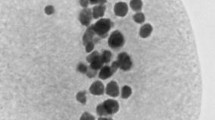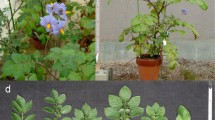Summary
A workable level of male and female fertility is present among many haploids (2n–24) obtained from the common potato,S. tuberosum (2n–48). However, the incidence of male fertility and the seed set obtained following numerous interhaploid matings have been consistently low. Hybrids between the cultivated diploid (2n–24) species (S. ajanhuiri, S. goniocalyx, S. phureja, S. stenotomum) and the pollen-fertileS. tuberosum haploids provide one means of overcoming this low fertility.
Crosses were made among 60 F1-hybrids, resulting fromS. phureja (♀) — haploidS. tuberosum (♂) matings, to determine their pollen and ovule fertility. These hybrids, which represent 16 combinations of 15S. phureja selections (from Plant Introductions 195198, 195214, 225678, 225683, 225685, 225701, 225708, 225710, 243461, 243462, 243466) with 2 malefertile haploids (US-W 1 fromKatahdin and US-W 42 from,Chippewa), were selected for desirable tuber characteristics and yield. All 60 hybrid selections were fertile both as males and as females. The seed set obtained was exceptionally high. No self-fertility was found.
The high incidence and level of male and female fertility suggests that lack of fertility is not likely to present an obstacle to future study of the potato at the 24-chromosome level.
Zusammenfassung
Ein brauchbarer Grad von männlicher und weiblicher Fertilität ist bei vielen, von der gewöhnlichen KartoffelS. tuberosum (2n–48) erhaltenen Haploiden (2n=24) vorhanden. Dennoch sind das Ausmass von männlicher Fertilität und der nach zahlreichen interhaploiden Paarungen erhaltene Samenansatz ständig schwach gewesen. Bastarde zwischen den kultivierten diploiden (2n–24) Arten (S. ajanhuiri, S. goniocalyx, S. phureja, S. stenotomum) und den pollenfertilenS. tuberosum-Haploiden stellen eine Möglichkeit dar, um diese schwache Fertilität zu überwinden. Fertile, kräftige Bastarde, einige davon mit überraschend guter Knollengrösse und gutem Ertrag wurden erzeug', wenn die Haploiden als Pollenspender gebraucht wurden. Die Bastarde, welche von den reziproken Kreuzungen stammten, waren ebenso kläftig, aber männlich-steril.
Um ihre Pollen- und Eizellen-Fertilität zu bestimmen, wurden Kreuzungen zwischen 60 F1-Bastarden vorgenommen, die aus Paarungen vonS. phureja (♀) mit, haploidenS. tuberosum (♂) hervorgingen. Diese Bastarde, die 16 Kombinationen von 15S. phureja-Auslesen (aus “Plant Introductions” 195198, 195214, 225678, 225683, 225685, 225701, 225708, 225710, 243461, 243462, 243466) mit zwei männlich-fertilen Haploiden (US-W 1 vonKatahdin und US-W 42 vonChippewa) darstellen, wurden auf wünschenswerte Knolleneigenschaften und Ertrag ausgelesen.
99% der möglichen 1.770 Kombinationen zwischen den 60 Eltern (1.755 Bestäubungen) und 84% der reziproken Kreuzungen (1.483 Bestäubungen) wurden vorgenommen, indem eine Bestäubung in jeder Richtung angewendet wurde. Der Erfolg nach reziproken Paarungen war mit dem aus Kombinationen, die nur in einer Richtung versucht wurden, vergleichbar (68% und 67% Beeren je Bestäubung). Alle Beeren zusammen brachten einen Durchschnittsertrag von 242 Samen je Beere und 92% ergaben mehr als 100 Samen je Beere (Tabelle 1).
Alle 60 Eltern erwiesen sich als männlich- und weiblich-fertil. Keine waren selbstfertil, obwohl alle funktionsfähige Eizellen und Pollen produzierten. Die Leistungen dieser Selektionen als männliche und weibliche Eltern sind nach Familien zusammengestellt (Tabelle 2). Die Mittelwerte für Einzelauslesen innerhalb einer Familie waren, von weinigen Ausnahmen abgesehen, den Familien-Mittelwerten vergleichbar. Die Zahl der erfolgreichen Bestäubungen zwischen enger verwandten F1-Auslesen war mit jener zwischen “nicht verwandten” Auslesen vergleichbar (Tabelle 3). Der durchschnittliche Samenansatz war hoch, ob die Paarung zwischen Geschwister-, Halbgeschwister- oder “nicht verwandten” Auslesen erfolgte.
Ein Vergleich zwischen den rohen (“raw”) Haploiden vonS. tuberosum und den 60 Bastarden ausS. phureja und haploidenS. tuberosum in bezug auf Triebkraft, Abblühen und Fettilität ist auffallend. Im Verlauf einer Vegetationsporiode blühten ungefähr 50% der Haploiden, zirka 30% wurden erfolgreich als weibliche Eltern verwendet, und 3% waren männlich-fertil (Tabelle 4). Demgegenüber blühten alle Bastard-Auslesen reichlich, und alle waren als männliche und weibliche Eltern funktionsfähig.
Das häufige Vorkommen und der hohe Grad von männlicher und weiblicher Fertilität weist darauf hin, dass der Mangel an Fertilität für zukünftige Studien über die Kartoffel mit 24 Chromosomen kaum ein Hindernis bildet.
Résumé
Il existe chez divers haploïdes (2n=24) obtenus de la Pomme de terre commune,S. tuberosum (2n=48), un niveau exploitable de fertilité mâle et femelle. Cependant les cas de fertilité mâle et les quantités de semences obtenues à la suite de nombreux croisements inter-haploïdes sont régulièrement bas. L'hybridation entre les espèces diploïdes cultivées (2n=24) (S. ajanhuiri, S. goniocalyx, S. phureja, S. stenotomum) et les haploïdesS. tuberosum à pollen fertile constitue un moyen de surmonter cette basse fertilité. En utilisant les haploïdes comme parents pollinisateurs, on a obtenu des hybrides fertiles, vigoureux, parmi lesquels plusieurs possèdent des qualités surprenantes de grande grosseur de tubercule et de productivité. Les croisements réciproques donnent des hybrides également vigoureux mais affectés de stérilité mâle.
On a effectué des croisements parmi 60 hybrides F1, provenant deS. phureja (♀) S. tuberosum haploïdes (♂), pour déterminer leur fertilité pollinique et ovulaire. Ces hybrides, représentant 16 combinaisons de 15 sélections deS. phureja (provenant des “Plant Introductions” 195198, 195214, 225678, 225683, 225685, 225701, 225708, 225710, 243461, 243462, 243466) avec deux haploïdes avec fertilité mâle (US-W 1 dekatahdin et US-W 42 deChippewa), avaient été choisis pour leurs bonnes propriétés de tubercule et de productivité.
99% des 1770 combinaisons possibles parmi les 60 parents (1775 pollinisations) et 84% des combinaisons réciproques (1483 pollinisations) ont été réalisées en pollinisant dans les deux sens. Les réussites des croisements réciproques et des croisements dans un sens seulement sont comparables (68 et 67% de fructification respectivement). Sur l'ensemble des baies, la production moyenne de semences par baie était de 242; 92% des baies donnaient plus de 100 semences par baie (Tableau 1).
Tous les 60 parents étaient fertiles à la fois comme mâle et comme femelle. Aucun n'était autofertile alors que tous produisaient des oeufs et du pollen fonctionnels. Les performances de ces sélections comme parents mâles et femelles sont résumées par familles dans leTableau 2. Les moyennes des sélections individuelles au sein d'une famille étaient, à part quelques exceptions, comparables aux moyennes de la famille. Les nombres de pollinisations fécondes parmi les sélections F1 les plus apparentées étaient comparables à ceux de sélections “non apparentées” (Tableau 3). La production moyenne de semences était élevée, que le croisement implique des sélections soeurs, demi-soeurs, ou “non apparentées”.
Les comparaisons de vigueur, de floraison et de fertilité entre les hybrides purs (“raw”) deS. tuberosum haploïde et les 60 hybridesS. phureja
S. tuberosum haploïde sont frappantes. Au cours d'une saison de croissance, 50% approximativement des haploïdes fleurissent, 30% approximativement sont utilisés avec succès comme parents femelles, et 3% ont la fertilité mâle (Tableau 4). Au contraire, toutes les sélections d'hybrides fleurissent abondamment et toutes sont des parents mâles et femelles fonctionnels. Le niveau élevé de fertilité mâle et femelle suggère qu'un manque de fertilité ne présente vraisemblablement pas un obstacle à l'étude ultérieure de la Pomme de terre au niveau de 24 chromosomes.
Similar content being viewed by others
References
Gabert, A. C., R. W. Hougas andS. J. Peloquin (1962): Haploid frequency inSolanum tuberosum following 4x−2x matings: Superior pollinators and superior seed parents.Amer. Potato J. 39, 391 (abst.).
Hawkes, J. G. (1958): Significance of wild species and, primitive forms for potato breeding.Euphytica.7, 257–270.
Hougas, R. W., andS. J. Peloquin (1960): Crossability ofSolanum tuberosum haploids with diploidSolanum species.Europ. Potato J. 3, 325–330.
Hougas, R. W., andS. J. Peloquin (1962a): VII. Exploitation ofSolanum germ plasm. The potato and its wild relatives. Texas Research Foundation, Renner, Texas, 606 pp.
Hougas, R. W., S. J. Peloquin andA. C. Gabert (1962b): The effect of seed parent and pollinator on frequency of haploids ofSolanum tuberosum. Crops Sci. (in press).
Hougas, R. W., S. J. Peloquin andR. W. Ross (1958): Haploids of the common potato.J. Hered. 49, 103–106.
Peloquin, S. J., andR. W. Hougas (1958): Fertility in two haploids ofSolanum tuberosum.Science.128 1340–1341.
Peloquin, S. J., andR. W. Hougas (1958): Decapitation and genetic markers as related to haploidy inSolanum tuberosum.Europ. Potato J. 2, 176–183.
Peloquin, S. J., andR. W. Hougas (1960): Genetic variation among haploids of the common potato.Amer. Potato J. 37, 289–297.
Peloquin, S. J., L. R. Mortenson andR. W. Hougas (1961): Germination ofSolanum pollen on artificial media.Amer. Potato J. 38, 370–371 (abst.).
Wangenheim, K. H. von (1962): Zur Kartoffelzüchtung auf diploider Stufe.Z. Pflanzenzücht.47, 172–180.
Author information
Authors and Affiliations
Additional information
Cooperation of the Inter-Regional Potato Introduction Project in providingSolanum materials is hereby acknowledged. This research was supported in part by a grant from the National Science Foundation.
Rights and permissions
About this article
Cite this article
Ross, R.W., Peloquin, S.J. & Hougas, R.W. Fertility of hybrids fromSolanum phureja and haploidS. Tuberosum matings. Europ. Potato J. 7, 81–89 (1964). https://doi.org/10.1007/BF02414417
Received:
Issue Date:
DOI: https://doi.org/10.1007/BF02414417




